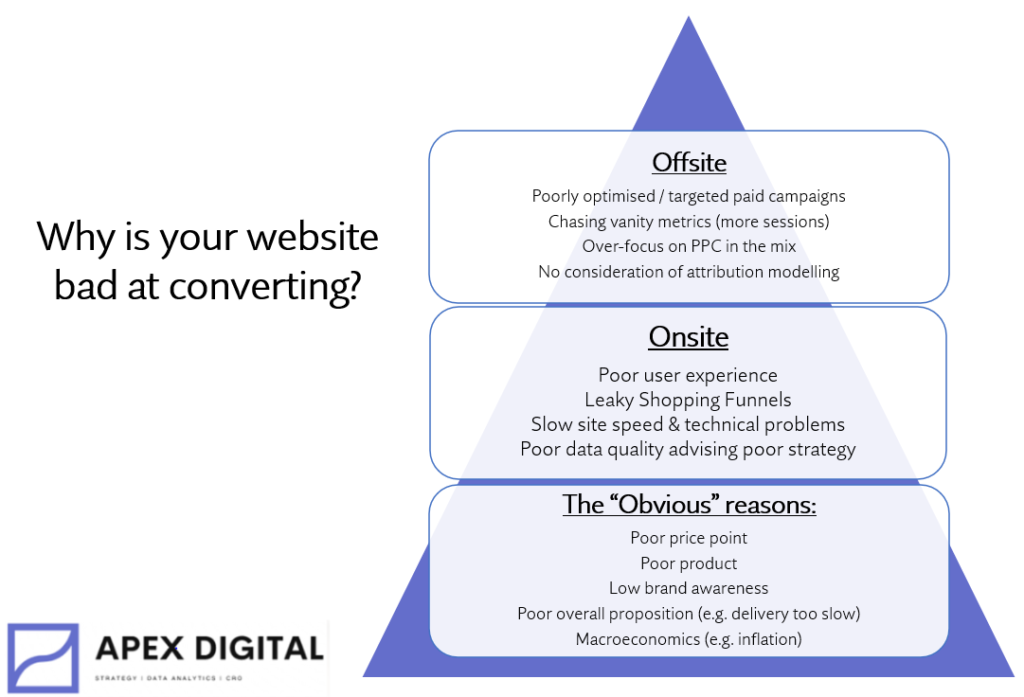CRO Best Practices to boost your online platform
Answering this question is why we have an industry around Conversion Rate Optimisation (CRO). This article will go over common mistakes and CRO best practices.
Fundamentally, understanding data and applying it to the business context is the key to success, however, it’s quite common for CRO to be misconstrued into something that it isn’t, and is very easily done badly.
Benchmarking is important
If we step back and contextualise the issue within the market where the website operates, several questions arise. Is the website focused on selling high-end luxury goods? Who constitutes the intended audience? How frequent is the need for customers to make repeat purchases?
The different combinations of each of these factors are unique to different businesses and are essential to understanding the performance of online proposition. Benchmarking gives us the confidence to say where we ought to be, before expending on CRO strategies that may or may not be required, we need to benchmark to set achievable goals.
Mostly when people talk about CRO, they mean the effectiveness of the website to convert the visitors (normally defined as sessions) into sales or leads, the rate of sales per 100 sessions gives us this conversion rate.
This is the most simplistic method of auditing, and it can mislead us due to long conversion paths and poor cookie retention for identifying users in today’s privacy centric contexts.
Session conversion rate also doesn’t explain why problems might be occurring, to get these reasons, we need to delve deeper into the data.
How to benchmark a website conversion rate

Websites selling luxury or long lifecycle goods may only have a conversion rate of 0.5%, but cheap consumer goods websites may well have a conversion rate ranging between 4 -8%. Both metrics could be considered excellent in the market where they exist.
After benchmarking the performance, we can determine if the conversion rate falls within our expectations, if it falls below expectations, then we need to identify why.
Mostly, this falls into one of three buckets:
The three buckets of CRO

The “Obvious” reasons:
Numerous reasons are self-evident and apply universally to businesses, whether operating online or offline. Often, the most basic reasons hinder conversion rates. The data to validate theories around these reasons can be obtained through applying “common sense” or qualitative data gathering. It’s surprising that many businesses overlook this step, so before investing resources in optimisation, it’s crucial to ensure these factors have been thoroughly researched.
These reasons are universal to any website’s success.
Offsite optimisation
Offsite activity has a direct impact on the onsite performance. Simply breaking down the conversion rate by traffic source indicates which traffic sources have a “problem” in terms of last click performance. In my experience, session conversion rate is inversely related to the amount of paid clicks driven. If there has been a big uptick in PPC spending, you may generate a higher sales volume, but on a curve of diminishing returns.
Offsite optimisation works for all, but is most impactful when applied to Low price – high demand goods by directing volume around in-market keywords to drive quality volume to a website. A CRO best practice is to take into account offsite optimisation almost as much as the onsite.
Onsite Optimisation
What most people mean when they talk about CRO. For me this is the most impactful piece of the puzzle that requires absolute data backed strategy, because it is data we can measure and leverage to our advantage in a direct way. We know that if we run an A/B test, direct 10,000 users to experience A and 10,000 users to experience B, and the latter has a higher session conversion rate to a significance level of >95%, then experience B is better.
Onsite is most impactful when applied to Essential / Distressed Purchases or luxury items, the demand exists, but the role of the website is to convert the demand into action.
Let’s dive a bit more into the common problems and CRO best practices with onsite optimisation..
Quantification is essential
Many businesses may not do A/B testing and may launch website updates without attempting to quantify uplift. Without this quantification, onsite CRO is an exercise of hope where so much effort trying to optimise an online experience only for the actions to have no impact, or worse, negatively impact performance. It is very important that businesses do not succumb to confirmation bias when it comes to attribution of credit to onsite experience without first contextualising around the other said buckets. Upticks in performance are usually a result of multiple factors, nothing ever happens in a vacuum.
Understanding the data is essential

Opinions about websites are mostly useless, use GA4 instead.
A common issue for marketing or product teams is a lack of data to produce or validate ideas to improve onsite performance. Opinion led ideation will never produce strong sales growth. The question to answer is, where to the problems lie?
Then begin to ask the questions behind the question:
- Do you struggle to generate clicks/sessions at all? (offsite factors)
- Is the product actually competitive in your market? (the “obvious” factors)
- Is the engagement rate low on certain landing pages?
- What proportion of your users view products, or add products to basket?
- What step of the checkout or lead generation funnel has the highest drop out rate?
- And so many more..
If you don’t know the answers to these questions, you need better data. Understanding the answers is crucial in the process of onsite CRO ideation for two reasons:
- Teams are usually time poor (you cannot optimise everything)
- We need to know the size of the potential uplift in revenue terms to ensure the time spent is going to have a material impact on all the key measures.
Businesses usually don’t facilitate effective onsite CRO
Optimising the onsite experience is very important and value adding work to be doing, however the other two buckets must be considered as part of the answer. Typically, the way businesses approach CRO is very siloed:
- The “obvious” reasons may be the responsibility of a trading manager or head of marketing
- The offsite performance may be managed by a performance marketing manager or often an external paid media agency.
- The onsite performance may be managed by merchandisers, design, product owners, web developers or external agencies, all with slightly different remits and objectives.
For example, it is in the interests of the acquisition team to drive traffic to the website, but don’t see conversion as their battle to be won, even though it directly impacts ROAS measures.
Similarly, the product team or external agency may treat onsite CRO almost as it’s own channel, and attribute revenue to it as incremental by annualising the revenue of winning tests and claiming it as money gained. This approach leads to a very short term attitude for producing results for each quarter, or to justify further spend on activity.
Onsite CRO should not be a political football within any organisation, cross functional collaboration between teams is another CRO best practice.
Onsite CRO is usually so short term in its outlook
Conversion rate (CVR%) in the usual way we think about it, is misleading us. As I discuss in my other post “the GA4 session; the most overused and misunderstood metric”, the session is the lowest form of attributing a user to activity. It is frequently the case where multiple sessions are not stitched together in default GA4 implementations due to cookie retention, leading us to measure only a snapshot of a true customer journey.
User IDs can have many sessions attributed to them

A session conversion rate could be 2%, and an analyst would conclude it was poor performing. If for the same website we saw a user conversion rate of 10%, this would indicate that our website was actually very effective, but we would never have come to that conclusion without analysing the data in this way.
Because of this fixation with sessions, we may try all the “low hanging fruit”, such as countdown timers or other urgency tactics in an attempt to increase our session conversion rate, but in doing so may harm our long-term conversion optimisation efforts through having a jarring and pushy UX that does not encourage this type of browsing behaviour.
The impact of short term viewed onsite CRO is exacerbated when we talk about thoughtful purchases in the top left of the benchmarking framework. This is where we would typically find the biggest discrepancy between the session and user CVR% because the multi touch journeys for these users will encapsulate more sessions within a user ID, therefore, for these websites it is crucial to view performance through this lens.
What I do differently

All of the reasons above indicate why some may be disillusioned with CRO as it exists today, but it doesn’t need to be like this. I prefer to call what I do as “enhancing conversion effectiveness” because to fixate on the short-term session metrics is a false economy. I will always look at the longer-term strategy and grow your website effectiveness in the correct way.
Get in touch with me today for your bespoke website & conversion rate audit
This will cover:
- Full audit of your GA4 (or other analytics tool) data quality.
- Full audit of your website performance, I will tell you exactly where your sales are getting lost.
- Key recommendations to improve conversion effectiveness.
- Further recommendations to improve your digital data quality.
- Data strategy consultation.
- Consultation on how best your team can adopt the CRO best practices in day to day business operations.
- Ongoing conversion enhancement partnership and experimentation.
Get in touch to discuss your website enhancement
Connect with me on LinkedIn